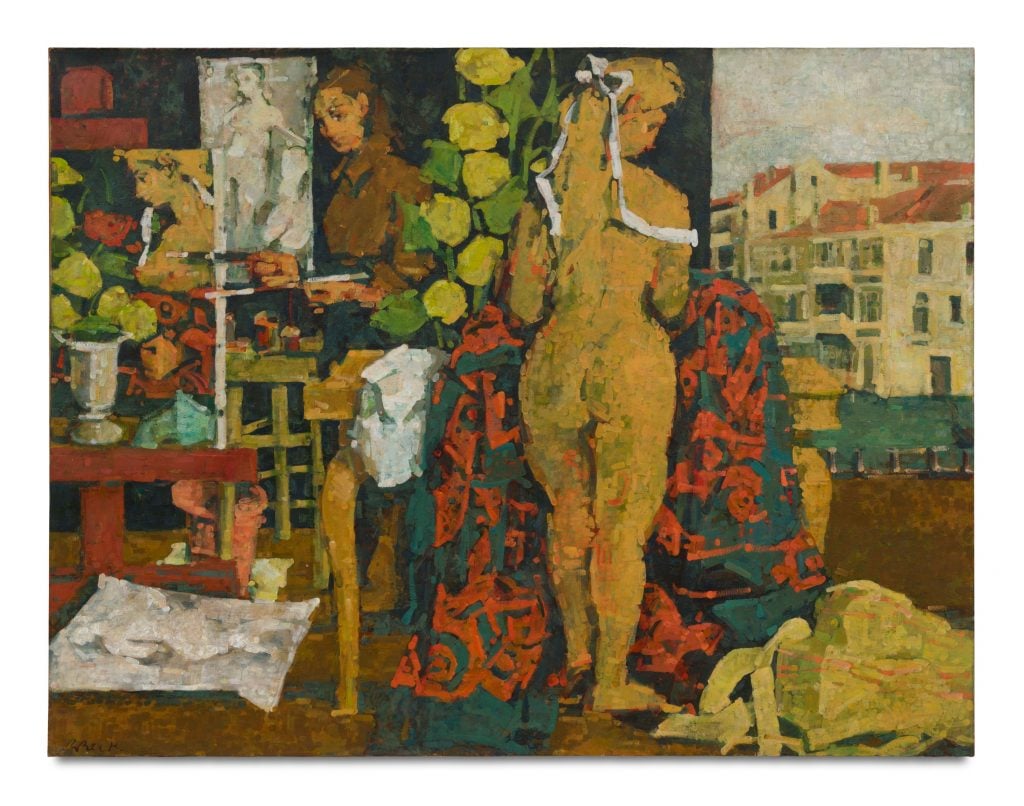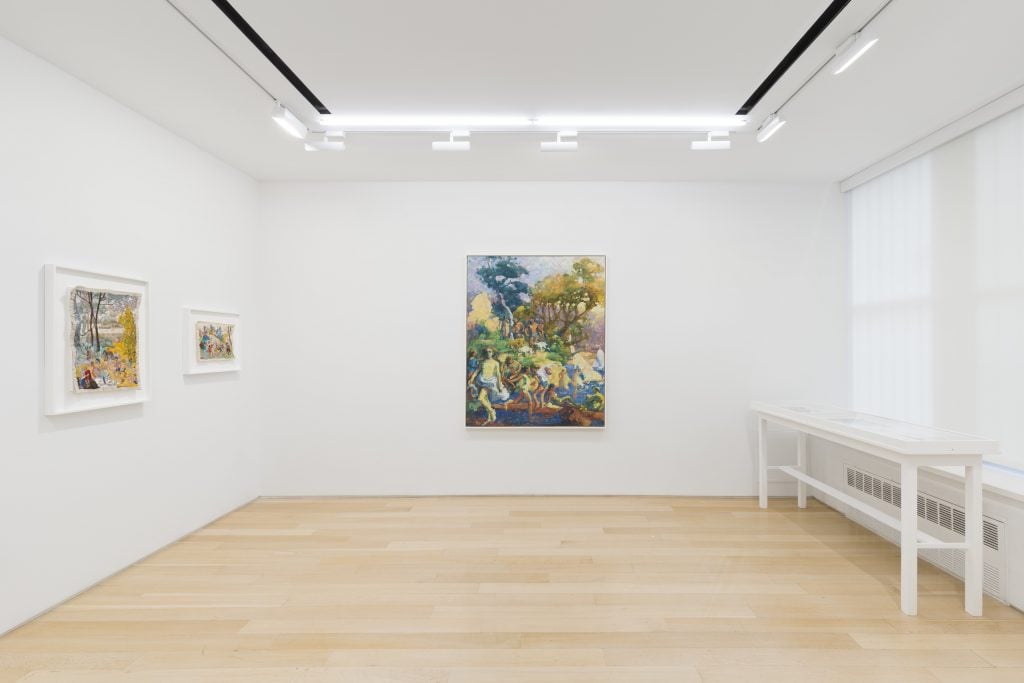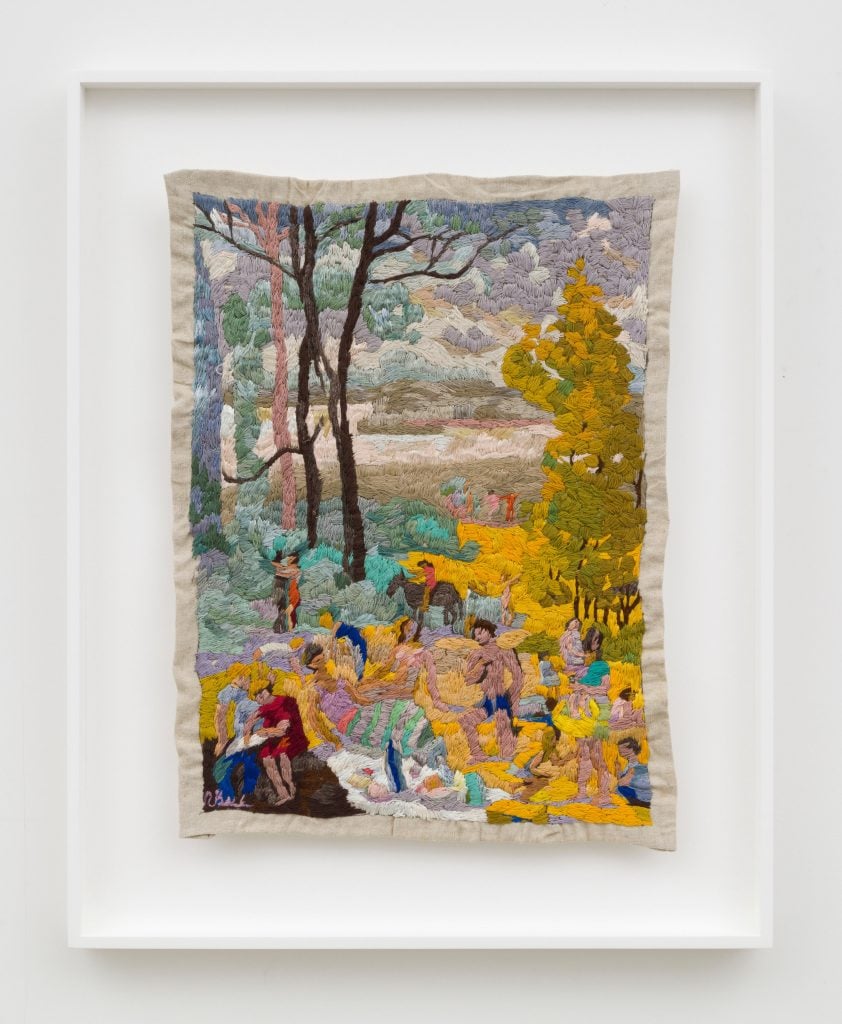
14 Nov Why Abstract Artist Rosemarie Beck Gave Up Fame For Figuration
Source Credit: Content and images from Artnet News. Read the original article - https://news.artnet.com/art-world/abstract-artist-rosemarie-beck-van-doren-waxter-2568826
She was a promising young artist whose luminous and gestural abstractions earned the attention of the New York art world in the 1940s and 1950s. But Rosemarie Beck’s fall into the marginalia of art history has its own twist.
In many ways, Beck had been celebrated by the establishment. In the 1950s, her works were exhibited, and collected by, the Whitney Museum of American Art. Robert Motherwell, a titan of Abstract Expressionism, took her on as a protege. She even earned the attention of Eleanor Ward, the legendary dealer who championed Louise Bourgeois and Robert Rauschenberg; Ward exhibited Beck’s work at her esteemed Stable Gallery.
Today, Beck (b. 1923) is little known, barely a footnote—that’s because in 1958, just as her career was rising, the artist decisively abandoned abstraction, feeling a call to a radiant style of figuration. For more than 40 years, until her death in 2003, she stayed true to her vision, painting dynamic mythological and literary themes, filled with rebellious women. “The ore in my abstract veins had thinned. I thought I would nourish my abstract painting by painting subjects. Then I couldn’t go back. I must have been a secret realist all along because I had never stopped drawing from life,” Beck recalled of this transition.
Her figurative works would garner attention for a time, with shows at Peridot Gallery and acquisitions by the Brooklyn Museum, the Corcoran, and the Hirshhorn. But Beck’s fame had crested and by the time of her death in 2003, she was little known even in curatorial circles.

Rosemarie Beck, Studio in Venice (1964). Courtesy of Van Doren Waxter.
But a moment of reappraisal for the artist has finally arrived. This week, “Rosemarie Beck: Earthly Paradise” opened at Van Doren Waxter in New York, a show that offers a tantalizing introduction to Beck and her rarely seen figurative works, through paintings, works on paper, embroideries, as well as photographs, sketches, writing, and correspondence.
“I was completely transfixed by the figuration,” said Elizabeth Sadeghi, partner at the gallery, recalling her first visit to the artist’s foundation over a year ago. Doria Hughes, the artist’s granddaughter, who runs the Beck’s foundation, had introduced herself to Sadeghi at Independent 20th Century art fair, a few years back. The gallery had presented the work of Hedda Sterne, a daring woman Abstract Expressionist, and Hughes took note.

Rosemarie Beck, painting in her studio.
“Twenty years ago, when I started archiving my grandmother’s work, I felt her art was neglected,” said Hughes. “I kept seeing shows of her male peers, people that she had taught with, worked with—Robert Motherwell, Philip Guston, Bradley Walker Tomlin. She was close with these people and they respected her and her work during her lifetime. I just kept thinking there have to be people out there who will recognize this treasure here of art.”
Van Doren Waxter became that place of recognition. Last year, the gallery showcased Beck’s work at Independent 20th Century. Soon after, it announced representation of her estate. “Earthly Paradise” marks the first exhibition of her work at the gallery.
More than 25 works made from 1959 to 2000 are on view, and chart her varied interests and influences, from Paul Cézanne to William Shakespeare. “Hers is a story that needs to be told,” said Hughes, “There’s a lot of inspiration and hope in her story and now is the time when we really need inspiration.”

Rosemarie Beck, Concert in Tuscany (circa 1989). Courtesy Van Doren Waxter.
That story begins with her childhood.
Beck was born in New Rochelle, New York, just north of New York City, to Hungarian-Jewish immigrants. She frequently traveled down to the city and grew up in a cultured milieu (Beck played the violin in addition to painting). After attending Oberlin College and earning a degree in art history, she would commit herself to painting, studying at Columbia University, the Art Students League in New York, and the Institute of Fine Arts at New York University. She and her husband, the writer and publisher Robert Phelps, moved to Woodstock, N.Y. soon after their wedding in 1945. Up in the wooded Catskill Mountains, she became close friends with Guston and Tomlin. During these early years of her career, she was regarded as a second-generation Abstract Expressionist. Her abstractions, which could appear like dappled sunlight, would ultimately be championed by artists including Kurt Seligmann and Robert Motherwell.
But a desire for the narrative pulled Beck back into figuration. Indeed, she may have been a “secret realist” all along. As the exhibition reveals, Beck kept her embroidery practice private throughout her adult life. Even at the height of her abstract career, her embroideries, several of which are included in the exhibition, had always been figurative, and her themes were often rooted in mythology, an unexpected union of “domestic craft” and the grand-scale themes of art history.

Installation view “Rosemarie Beck: Earthy Paradise” at Van Doren Waxter, 2024. Photography by Charles Benton. Courtesy Van Doren Waxter.
“For a woman during that time, it’s pretty extraordinary. Beck signed a lot of them, too. She meant them to be pieces that she put in the world,” added Sadeghi. Her paintings, meanwhile, subtly hint at her own dynamic, unabashed personality. One of the most evocative works in the exhibition, Studio in Venice (1964), is a self-portrait Beck made while in the Italian city (the canals are visible beyond her studio window).
“She went to Venice, Italy, and had an extended trip there, and took a studio. Being exposed to all that incredible history of figurative art and churches and frescoes emboldened her to listen to her calling and really move back into figuration,” said Sadeghi.
In this painting, Beck places herself in the lineage of male artists captured behind the easel, from Diego Velasquez to Vincent Van Gogh, along with women artists who had claimed their stake such as Sofonisba Anguissola and Lavinia Fontana. A thread of self-portraiture runs through her work, part of which was born of necessity; she was often trying to make do financially and her face was her most affordable model. Still, her own personality emerges.
“Her paintings have these visual breadcrumbs for you to pick up. Sometimes she looks out from the painting and makes bold eye contact and asserts herself as the artist,” said Hughes. “She was unashamed. Not demure. That was never her.”
Critic Martica Sawin described Beck as “one of the few painters of our time to treat grand themes in ambitious multi-figure compositions while satisfying a need both for abstract structure and for an execution that embodies energy without being gratuitous.” This approach has sometimes been linked to the influence of Cézanne. Her 1985 painting Bathers, included in the show, seems a direct response to Cézanne’s 1894 Bathers, only Beck has replaced his standing men with women.

Rosemarie Beck, Untitled (1986). Courtesy of Van Doren Waxter.
Often her paintings include imagery of women who are defiant and powerful. The work Apollo and Daphne (1982) imagines Daphne the moment before she is transformed into a laurel tree, a metaphor for sexual violence. In another work, Diana and Actaeon (1985), she depicts the hunter Actaeon surprising the bathing goddess just before she splashes him with water and changes him into a deer. While Hughes wouldn’t define Beck as a proto-feminist, she added: “As a woman painter, she just painted it as she saw it.”
Theater also emerges as a key theme in her work. In an essay for the exhibition catalogue, art historian Jessica Holmes notes “[Beck’s] penchant for theatrical mise-en-scène.” Her Bathers painting was part of a larger cycle of paintings inspired by William Shakespeare’s The Tempest. The artist spent a good five years working through a series centered on the play. Her earliest interludes with art came through the lens of theater, in fact. While still in high school, she was given free rein to the school’s backstage, painting stage sets, doing makeup, and acting. In college, she was part of the Oberlin Dramatic Association.

Rosemarie Beck, Study, Two in a Room (1967). Courtesy of Van Doren Waxter.
When it came to The Tempest, Beck identified with Prospero. “It’s clear from her journals that she thought the way Prospero could wield his magic wand was analogous to her as a painter wielding her brush—a brush of wand or the brush that you can use to change reality.”
Throughout decades of her life, Beck struggled with her outsider status. “She could be a bit obstreperous and she wrote a lot in her journals about her private frustrations and feeling overlooked,” said Hughes, “The bottom line is that she needed to paint these paintings.”
For many years, Beck channeled her energies into teaching. Over the decades, she taught at Queens College of New York, Vassar College, Middlebury College, the Vermont Studio Center, and Parsons School of Design. She was on the faculty of New York Studio School until shortly before her death. Even in her last moments, Hughes recalled, students were coming by to show her their work.
“She forged a reality for herself and forged that path and possibility for people afterward, too, through teaching,” said Hughes. In some ways, she is still teaching: the Rosemarie Beck Foundation, which is based in the Lower East Side, hosts an artist residency. “She was Prospero” she added. “She was her own magician.”
Source Credit: Content and images from Artnet News. Read the original article - https://news.artnet.com/art-world/abstract-artist-rosemarie-beck-van-doren-waxter-2568826

